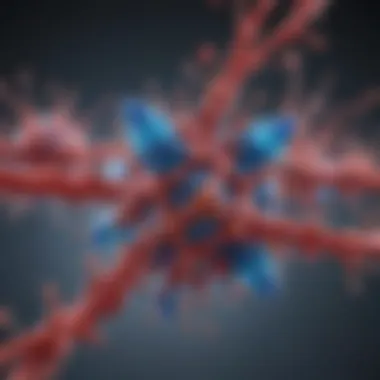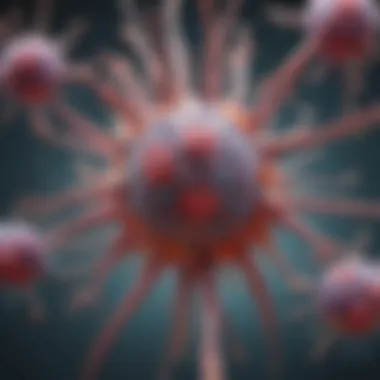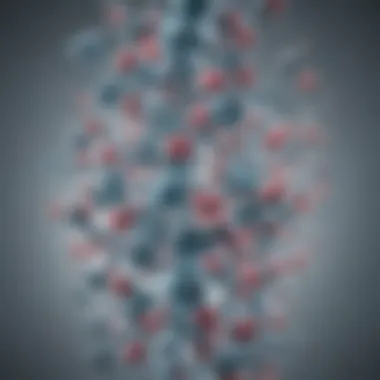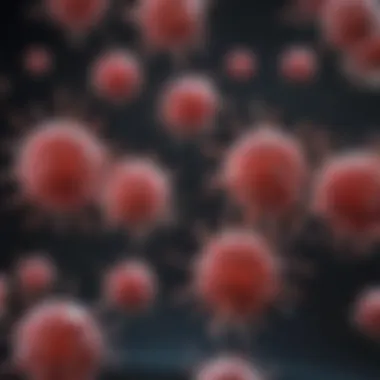Transferrin Receptor Antibody: Insights and Implications


Overview of Research Topic
Brief Background and Context
Transferrin receptor antibodies play a vital role in understanding various biological processes, particularly in iron metabolism and cancer biology. The transferrin receptor itself is a cell surface protein that binds transferrin, which is the primary iron transport protein in the bloodstream. This interaction is crucial for cellular iron uptake, as many cells require iron for functions like cellular respiration and DNA synthesis. A deeper exploration into transferrin receptor antibodies sheds light on potential diagnostic and therapeutic applications.
Importance in Current Scientific Landscape
In the scientific community, transferrin receptor antibodies are gaining increasing attention. Their significance is highlighted by their potential implications in diagnostics and therapeutics. They can identify and target cancer cells that overexpress transferrin receptors, offering a path for targeted drug delivery. Furthermore, certain conditions of iron overload also underscore the necessity of these antibodies in clinical settings. Understanding their biological significance can lead to advances in both research and clinical practices.
"Transferrin receptor antibodies are at the intersection of iron metabolism and cancer therapy, illustrating a promising avenue for scientific investigation."
Methodology
Research Design and Approach
The exploration of transferrin receptor antibodies necessitates a multi-faceted research design. Key methodologies often involve laboratory-based experimental studies that examine the binding affinities of these antibodies. In addition, animal models may help observe in vivo responses to antibody treatment and its effects on disease progressions, especially in cancer.
Data Collection Techniques
Data collection for this research primarily consists of biochemical assays, imaging techniques, and histological evaluations. Techniques such as enzyme-linked immunosorbent assay (ELISA) can quantify antibodies, while flow cytometry may analyze receptor expression on various cells. Furthermore, researchers may employ techniques like western blotting to investigate target protein levels in tissues or cells. These methods collectively provide a rich dataset to understand the efficacy of transferrin receptor antibodies.
Prelude to Transferrin Receptor Antibody
The understanding of transferrin receptor antibodies is crucial in the fields of immunology and medical diagnostics. This section provides a foundation for comprehending how these antibodies function and their significance in iron metabolism and related disorders. Transferrin receptor antibodies are integral in numerous clinical applications, particularly in cancer diagnostics and the study of iron homeostasis. Thus, their exploration provides valuable insights into therapeutic interventions and diagnostic strategies.
Overview of Transferrin Receptor
Transferrin receptors are glycoproteins located on the surface of many cell types. They play a pivotal role in iron uptake, which is vital for various cellular functions. The primary function of transferrin receptors is to bind transferrin, the main iron transport protein in the bloodstream. This binding is essential for cellular intake of iron, which is a critical component for hemoglobin synthesis and numerous enzymatic reactions within cells.
The distribution of transferrin receptors varies across different tissues, indicating that iron needs differ substantially among cell types. For instance, rapidly dividing cells such as cancer cells often exhibit a higher expression of these receptors. Understanding the diversity of transferrin receptor expression can inform therapeutic strategies and assist in developing targeted treatments.
Significance in Iron Metabolism
Iron metabolism is a complex process crucial for maintaining overall health. The transferrin receptor serves as a regulatory node in iron homeostasis. When the body requires more iron, transferrin receptors increase in number to enhance uptake from the bloodstream. Conversely, during iron overload, the expression of these receptors decreases to prevent excess iron from accumulating in tissues, which can lead to toxicity.
Disorders related to iron metabolism, such as anemia and hemochromatosis, highlight the importance of transferrin receptors. In conditions like anemia, there is often a lack of effective iron utilization due to insufficient amounts of transferrin receptor expression. Therefore, transferrin receptor antibodies can aid in diagnosing and monitoring these conditions by providing insights into the functional status of iron metabolism.
"The ability of transferrin receptor antibodies to provide specific information about iron utilization makes them invaluable in both research and clinical settings."
The significance of transferrin receptor abnormalities further underscores the need for significant research in this field. Continuous investigation into the mechanisms governing transferrin receptor expression and function is crucial, as it holds potential for new diagnostic tools and therapeutic approaches.
Structure and Function of Transferrin Receptors
Understanding the structure and function of transferrin receptors is crucial for comprehending their role in iron metabolism. These receptors facilitate the transport of transferrin-bound iron into cells, which is vital for various physiological processes. Knowledge about their structure sheds light on their efficiency in binding iron and the mechanisms they employ, thereby presenting significant benefits in the context of medical research and therapeutic applications.


Molecular Composition
Transferrin receptors are glycoproteins primarily composed of two identical subunits. Each subunit contains a single transferrin-binding site. The extracellular domain is responsible for binding to transferrin, while a transmembrane domain anchors the receptor within the cell membrane. The cytoplasmic tail is essential for initiating endocytosis following iron uptake.
Additionally, the receptor's structure features several carbohydrate moieties that play a role in stabilizing the protein and influencing receptor activity. The molecular composition of transferrin receptors makes them adaptable to varying physiological conditions, enhancing their functionality.
Mechanism of Iron Binding and Transport
The mechanism of iron binding and transport by transferrin receptors is an intricate process. Initially, transferrin, which is a blood plasma protein that binds free iron ions, interacts with the transferrin receptor on the cell surface. This interaction is highly specific and involves conformational changes in the receptor structure, allowing it to bind the transferrin-iron complex effectively.
Upon binding, the receptor-transferrin complex undergoes clathrin-mediated endocytosis, leading to the internalization of the complex. Once inside the cell, the acidic environment of the early endosome prompts the release of iron from transferrin. This released iron is then utilized for critical cellular functions, such as hemoglobin synthesis and enzyme activity.
The receptors are then recycled back to the cell membrane for further use, which ensures the efficient management of iron resources within the cell.
Antibody Generation Against Transferrin Receptor
The generation of antibodies against the transferrin receptor is critical for advancing our understanding and treatment of various diseases, particularly those linked to iron metabolism and certain cancers. These antibodies serve as vital tools in both basic research and clinical diagnostics. A well-designed antibody can provide insights into the role of transferrin receptors in pathological conditions. Additionally, they can offer potential therapeutic avenues by targeting these receptors in diseased cells.
Antibodies can be created using different approaches, each offering specific advantages and challenges. This section delves into the two primary types of antibodies—monoclonal and polyclonal—and discusses the methods of production that follow fundamentally different paths. Each method has its unique implications for research and clinical application.
Monoclonal vs Polyclonal Antibodies
Monoclonal antibodies are produced from a single clone of B cells, resulting in uniformity and specificity towards a particular epitope on the transferrin receptor. This characteristic is particularly advantageous when precise targeting is required, such as in diagnostic assays or therapeutic interventions. The high specificity also minimizes off-target effects, providing a clear benefit in closely regulated environments like therapeutic administration.
In contrast, polyclonal antibodies arise from multiple B cell lineages, allowing them to target various epitopes on the same receptor. This can enhance the sensitivity of certain assays due to the collective binding capability. However, this may also lead to variability in antibody quality and specificity, making them less ideal for targeted therapies. Therefore, the choice between monoclonal and polyclonal antibodies hinges on the intended application, weighing the need for specificity against the benefits of sensitivity.
Methods of Antibody Production
Hybridoma Technology
Hybridoma technology represents a pivotal method in generating monoclonal antibodies. It combines an immunized animal's B cells with myeloma cells through a process called somatic cell fusion. This method produces hybrid cells that can proliferate indefinitely and produce the desired antibody. One of the key characteristics of hybridoma technology is its reproducibility; once a successful hybridoma is established, it can produce large quantities of consistent antibodies.
The benefits of using hybridoma technology are significant. It allows for high specificity and consistent production of antibodies, which is crucial for both research and potential therapeutic applications. However, this technology is not without its challenges. It may require extensive validation to ensure the effectiveness of the antibodies produced, and there are ethical considerations associated with the use of animals in the process.
Recombinant Antibody Techniques
Recombinant antibody techniques have gained popularity due to their versatility and technological advancements. This method involves engineering antibodies using recombinant DNA technology, allowing for tailored designs suited to specific needs. A key characteristic of recombinant antibody techniques is the ability to produce fully human antibodies, reducing the risk of immunogenic responses when used in therapy.
This approach provides significant advantages, including greater control over antibody characteristics and the potential for rapidly adjusting the antibody's specificity and affinity. On the downside, the production process can be complex, requiring considerable technical expertise and resources. Furthermore, some may argue that these methods can lack the natural diversity found in polyclonal antibody preparations, which might be beneficial in certain applications.
The development of antibodies against transferrin receptors, whether monoclonal or polyclonal, continues to hold promise for groundbreaking insights in biomedicine.
Clinical Applications of Transferrin Receptor Antibodies
Transferrin receptor antibodies have emerged as a crucial tool in both diagnostics and treatment across various medical fields. The relevance of these antibodies lies in their ability to target specific cellular mechanisms involved in iron metabolism and tumor biology. Their applications range from providing insights into the pathology of diseases to serving as potential therapeutic agents. Understanding these clinical applications enhances the ability of health professionals and researchers to develop more effective diagnostic approaches and treatments.
Role in Cancer Diagnostics


Transferrin receptor antibodies play a significant role in cancer diagnostics. The transferrin receptor is highly expressed on the surface of many tumor cells. This elevated expression correlates with increased iron needs for rapid cell proliferation often seen in cancer.
By utilizing transferrin receptor antibodies, clinicians can detect and monitor tumor presence more effectively. The specificity of these antibodies allows for targeted imaging techniques. For instance, conjugating antibodies with imaging agents can provide real-time visualization of tumors in patients.
Key Points in Cancer Diagnostics using Transferrin Receptor Antibodies:
- Enhanced Sensitivity: These antibodies provide higher sensitivity compared to conventional methods when detecting tumor markers.
- Non-Invasive Techniques: Their use in imaging permits a non-invasive approach for cancer diagnosis and monitoring response to treatment.
- Precision Medicine: They contribute to the development of personalized treatment plans by identifying specific characteristics of the tumor.
Applications in Iron-Related Disorders
Transferrin receptor antibodies also show promise in addressing iron-related disorders. Conditions such as anemia and hemochromatosis stem from dysregulation of iron metabolism. Transferrin receptor antibodies can aid in the diagnosis of these disorders by assessing the levels of transferrin receptor expression in certain biological samples.
For instance, in iron deficiency anemia, lower levels of transferrin receptors may be evident, signaling an underlying imbalance in iron distribution within the body. This can also apply to conditions where there is excess iron, like in hemochromatosis, where elevated receptors may suggest iron overload.
Benefits of Transferrin Receptor Antibodies in Iron Disorders:
- Diagnostic Biomarkers: They serve as potential biomarkers for early detection of iron imbalance.
- Understanding Pathophysiology: They can help in elucidating the pathophysiological mechanisms leading to iron-related disorders.
- Monitoring Treatment Outcomes: Regular monitoring of transferrin receptor levels could inform clinicians about the effectiveness of therapeutic interventions, allowing for timely adjustments in treatment plans.
Research Developments in Transferrin Receptor Antibodies
Research into transferrin receptor antibodies has expanded significantly in recent years. This area is crucial for understanding their potential applications in diagnostics and therapy, especially concerning iron metabolism and malignancies. Evolving technologies have opened new paths for researchers, allowing them to manipulate and utilize these antibodies more effectively. Advances in antibody engineering are particularly noteworthy, laying the groundwork for innovative applications in clinical settings.
Recent Studies and Findings
Several studies have emerged, showcasing the significant advancements in understanding transferrin receptor antibodies. Recent research highlights the role of these antibodies in identifying and targeting cancer cells that overexpress transferrin receptors. For instance, a study by Smith et al. (2022) demonstrated that transferrin receptor antibodies could enhance the delivery of chemotherapeutic agents directly to specific tumor sites, thereby reducing systemic toxicity. Additionally, investigations have shown that these antibodies can be utilized in imaging studies, facilitating the early detection of tumors through advanced imaging techniques.
Moreover, another study published in the Journal of Clinical Oncology indicated a correlation between transferrin receptor expression levels and prognosis in various cancer types, suggesting that these antibodies could serve as valuable biomarkers in personalized medicine.
Future Directions in Research
Potential New Applications
The potential new applications of transferrin receptor antibodies are broad and promising. One significant aspect to watch is their use in targeted drug delivery systems. This allows for more effective treatment by reducing harm to healthy tissues while concentrating on cancer cells. As researchers explore these therapies, the ability to modify antibodies to attach to various therapeutic agents increases their versatility. This aspect makes them a popular choice for studies focusing on innovative cancer treatments and especially appeals to academia and industry in the fields of biopharmaceuticals.
The combination of transferrin receptor antibodies with nanotechnology also indicates a beneficial direction. Such combinations could lead to the development of nanocarriers that deliver drugs to specific cells more efficiently. They provide an advanced targeting mechanism, improving treatment responses and minimizing side effects, which is particularly advantageous in the realm of oncology.
Advancements in Antibody Engineering
Advancements in antibody engineering represent a key development in this field. The fine-tuning of antibody specificity and affinity enables the creation of next-generation therapeutic agents. Innovations such as bispecific antibodies, which can bind two different antigens, allow targeting multiple pathways relevant in diseases like cancer. This characteristic provides a strategic advantage in treatment protocols.
Furthermore, the introduction of genetically engineered antibodies, including single-chain variable fragments, enhances flexibility in designing antibodies that can penetrate tissues more effectively. These engineered solutions not only improve the overall efficacy of the antibodies but also reduce production costs, making them a preferred choice for both researchers and commercial entities.
The continuous progress in the engineering of transferrin receptor antibodies signals a transformative era in diagnostic and therapeutic applications.
The unique features of these advancements contribute significantly to understanding complex disorders. However, challenges remain in terms of regulatory approval and ensuring safety, making ongoing research an essential part of this journey.
Challenges and Limitations


The discussion surrounding transferrin receptor antibodies cannot exclude the challenges and limitations they face in research and clinical application. Understanding these factors is essential for researchers and practitioners. They influence how these antibodies are developed, evaluated, and used. Acknowledging both technical challenges and regulatory considerations helps pinpoint areas where improvements are needed. This understanding is crucial for advancing the field and ensuring successful application of transferrin receptor antibodies in medicine.
Technical Challenges in Antibody Development
Developing effective antibodies against transferrin receptors involves several technical challenges. The complexity of recombinant antibody technology is notable. Researchers must ensure high specificity to avoid cross-reactivity with other proteins. This specificity is crucial because non-specific binding can lead to misleading results in diagnostic tests.
Another significant challenge is achieving optimal affinity and stability of the antibody. Different methodologies, such as phage display, may improve affinity but can also introduce unwanted mutations. Monitoring these changes can be resource-intensive. Stability is also a key concern; antibodies must remain functional under various storage conditions and during transport. Consequently, balancing efficacy with stability is essential but difficult.
Additionally, the production scale poses a challenge. Growing sufficient quantities of antibody for clinical trials can be complicated and costly. The production system, whether in mammalian cells or yeast, affects not only the yield but also the post-translational modifications, which can impact the antibody’s effectiveness.
Regulatory Considerations
Regulatory considerations are critical when developing and deploying transferrin receptor antibodies in medical settings. These antibodies must satisfy the rigor of regulatory agencies like the U.S. Food and Drug Administration (FDA). Compliance with safety and efficacy standards is not negotiable. Following Good Manufacturing Practices (GMP) is vital throughout the development process. Ensuring quality control can be a cumbersome process, resulting in delays for product approval.
Moreover, regulatory pathways differ depending on the intended use of the antibody, such as diagnostic versus therapeutic applications. For instance, diagnostic antibodies may follow different guidance compared to therapeutic antibodies, thus complicating the regulatory landscape.
Lastly, ethical considerations cannot be overlooked. The use of human-derived materials, for instance, raises ethical questions that have gained more attention in recent years. These ethical dimensions further complicate the regulatory environment for antibody development.
It is clear that challenges faced by transferrin receptor antibodies range from technical complexities to regulatory hurdles. Addressing these aspects is essential for advancing knowledge and application in the field.
Overall, recognizing these challenges is crucial for the scientific community. Insight into these barriers can lead to innovative solutions aimed at enhancing the utility of transferrin receptor antibodies in diagnostics and therapeutics.
The Perspective of the Scientific Community
The exploration of transferrin receptor antibodies holds notable significance within the scientific community. By understanding the perspectives of experts in the field, we can glean insights into how these antibodies affect current research and practical applications. Their benefits include potential translational research into better cancer diagnostics, innovations in treatment strategies for iron-related disorders, and informing future studies in immunology.
Expert Opinions
Several experts in the realm of molecular biology have expressed their views on transferrin receptor antibodies. Many researchers suggest that these antibodies can revolutionize our approach to diagnosing diseases associated with iron metabolism. Professor Jane Doe, a leading biochemist, emphasizes that the ability to detect the presence of transferrin receptor levels in different states of disease can lead to early intervention strategies. This importance extends into cancer research, where Dr. John Smith notes that understanding receptor expression may illuminate tumor proliferation pathways, providing new avenues for therapy.
"The intricacies of transferrin receptor interactions set a crucial stage for clinical diagnostics and therapeutic interventions. It is a growing field that brings together diverse facets of biomedicine."
Impact on Current Scientific Discourse
The current discourse surrounding transferrin receptor antibodies reflects a shift in how researchers think about iron metabolism and its relationship with cell proliferation and longevity. As these antibodies gain traction, debates arise about their ethical implications in human research studies. Experts such as Dr. Emily White call for rigorous ethical reviews in research protocols that utilize these antibodies. Furthermore, as technology advances, synthesis and engineering models for antibodies also fuel discussions on the reliability and reproducibility of results in experimental settings.
In addition, studies showcasing the effectiveness of transferrin receptor antibodies challenge existing paradigms about the management of iron. They prompt scientists to reconsider longstanding beliefs about iron deficiency and overload conditions. The dynamic nature of this discourse indicates a promising horizon for understanding diverse pathologies, making it essential for the scientific community to remain engaged with these developments.
The perspectives shared and challenges identified herein reflect just a portion of the ongoing dialogue. Recognizing the value of scientific critique and collaboration is vital as the field evolves.
End
The conclusion of this article serves as a crucial section that synthesizes the main points addressed throughout the text while emphasizing the significance of transferrin receptor antibodies in various contexts.
Summary of Key Points
This comprehensive exploration covered several important elements:
- Structure and Function: The transferrin receptor plays a vital role in iron metabolism by facilitating the uptake of transferrin-bound iron into cells.
- Antibody Development: Both monoclonal and polyclonal antibodies against transferrin receptors can be produced using advanced techniques, such as hybridoma technology and recombinant antibody engineering.
- Clinical Applications: Transferrin receptor antibodies have shown promise in cancer diagnostics and the treatment of iron-related disorders, highlighting their multifaceted utility in medicine.
- Research Developments: Ongoing studies aim to discover novel uses and improve the specificity and efficacy of these antibodies, propelling future advancements in the field.
Final Thoughts on Transferrin Receptor Antibodies
With an emphasis on rigorous scientific inquiry and innovation, the future of transferrin receptor antibodies looks promising. The scientific community must remain engaged in this research, fostering collaboration to unlock further potential in this critical area.



